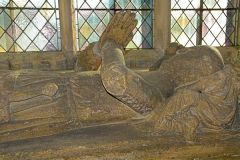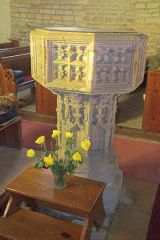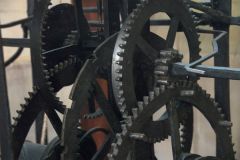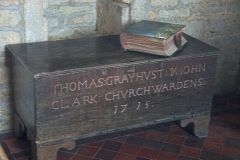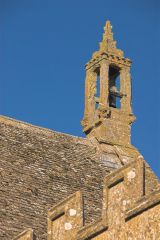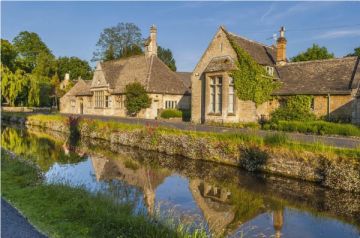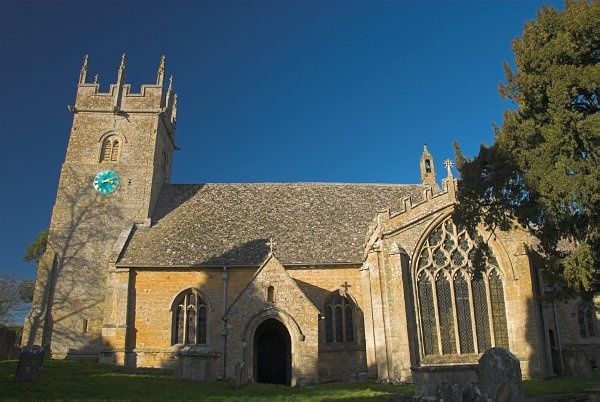
Summary
A 12th-century church situated in the lovely little Cotswold village of Longborough.
We don't know for sure how long the parish church of St James has stood in Longborough. It is possible that the church dates back to the Saxon period, but it seems likely that it existed in the early Norman period at the latest. The first recorded rector of St James was William of Luton in 1264.

The most intriguing aspects of St James are contained in the transepts. Let's take the south transept first. The transept is lit by a very large set of traceried stained glass windows, creating an unusually light and airy space.
There are two tombs set against the south wall of the transept. To the east is a 14th-century table tomb, with the carved figures of a knight in armour and his wife. The carving on the head of the effigies is worn, but the feet are in very good repair. The pose of the knight is intriguing; his feet are set at angles, one above the other, and resting on an animal that may be a dog.
Beside the medieval tomb is a grandiose Jacobean memorial to Sir William Leigh (d. 1631) and his wife Elizabeth (d. 1664). The carving is exquisitely detailed, though the decoration is subdued by comparison to many tombs of this period. At the base of the tomb are friezes of the couple's sons and daughters in a kneeling pose.
The Latin inscription upon the tomb has been translated on an informational plaque beside the tomb. It reads:

The Sezincote Chapel
In 1822 the Cockerell family of the neighbouring parish of Sezincote were granted the right to build a family chapel in St James, as their own church in Sezincote had fallen into disrepair. The Cockerells built their chapel and burial vault in the north transept.
The vault was used for only eight burials, then it was bricked up. The chapel stands on top of the vault, with the result that the north transept is raised to a level of four or five feet above the level of the nave, creating a sort of galleried transept accessible only by a set of stairs.
The largest and grandest memorial in the Sezincote Chapel is to Charles Cockerell (1755 - 1837). On the north wall is the memorial to Sir Charles Rushout Rushout. Sir Charles was born Charles Rushout Cockerell, the son of the first Sir Charles. In 1837 he had his name changed to the redundant 'Charles Rushout Rushout' in order to claim an inheritance through his mother's family.
Tucked into a corner of the Sezincote Chapel is a turret clock dating to sometime between 1699 and 1752. The frames supporting the clock mechanism is probably earlier still. The clock was found in pieces in the tower in 1987 and was reassembled here. It is in working order though it is not in daily use.
Visiting
There is limited parking right outside the church, but there are numerous side streets nearby where you should be able to find a parking spot. There's a nice pub just up the road, too!
About Longborough
Address: Church Street,
Longborough,
Cotswolds,
Gloucestershire,
England
Attraction Type: Historic Church
Location: On Church Street, just down from the War Memorial. Church Street is opposite the Coach and Horses Inn. Limited parking outside the church.
Location map
OS: SP179297
Photo Credit: David Ross and Britain Express
HERITAGE
 We've 'tagged' this attraction information to help you find related historic attractions and learn more about major time periods mentioned.
We've 'tagged' this attraction information to help you find related historic attractions and learn more about major time periods mentioned.
Find other attractions tagged with:
12th century (Time Period) - 14th century (Time Period) -
NEARBY HISTORIC ATTRACTIONS
Heritage Rated from 1- 5 (low to exceptional) on historic interest
Sezincote - 1 miles (Historic House) ![]()
Bourton House Garden - 1.7 miles (Garden) ![]()
Broadwell, St Paul's Church - 1.8 miles (Historic Church) ![]()
Upper Swell, St Mary's Church - 1.8 miles (Historic Church) ![]()
Stow-on-the-Wold, St Edward's Church - 2.6 miles (Historic Church) ![]()
Batsford Arboretum - 2.6 miles (Garden) ![]()
Evenlode, St Edward's Church - 2.6 miles (Historic Church) ![]()
Batsford, St Mary's Church - 2.6 miles (Historic Church) ![]()
Nearest Holiday Cottages to Longborough:
Longborough, Gloucestershire
Sleeps: 6
Stay from: £542 - 2040
Stow-on-the-Wold, Gloucestershire
Sleeps: 4
Stay from: £477 - 1323
More self catering near Longborough
